How to de-risk projects and overcome management doubt

“The less I know, the more I like it.” That’s how a business leader described his experience with big R&D projects to me. What looks wonderful at first often perishes later, sometimes dragging careers with it. During your project reviews, is management hearing, “Trust me, you’ll love this”? There’s a better way, one that puts you and management on the same team. Here’s how…
Top-performing teams know how to de-risk projects with intelligence and rigor. They…
- Separate facts from assumptions at the onset.
- Avoid unforeseen “landmines” late in the game.
- Succeed rapidly, without detours and distractions.
- Spend funds efficiently on only that which matters.
But clever project de-risking is only half the battle. The other half is gaining the confidence of the entire leadership team. Few teams do this well. Instead they assemble detailed PowerPoint presentations focused on the project’s good points. Within 3 or 4 slides, they confound everyone except their sponsor, the technology head.

What if your project reviews looked like this instead:
- Everyone on the leadership team—HR, Finance, Legal—understands your project de-risking plan and progress.
- Because you’ve explained potential landmines early, management is confident you aren’t “hiding the pea.”
- They see you’re investigating critical assumptions fast and cheaply, so they don’t second-guess or micro-manage.
- When it’s time for investment decisions, they’re made quickly and wisely… because these leaders have been on the journey with you.
Good things happen with this approach. First, if the project dies, it’s not your fault. Your team took the most professional, least expensive and fastest route to a good business decision… and your leaders know it.
Second, you’ve given your project more time if needed. Patience runs out faster when a project looks like a black box into which money is poured. But when you de-risk projects transparently with management, they are much more tolerant of unavoidable delays and setbacks.
Patience runs out faster when a project looks like a black box into which money is poured.
In this article, we’ll provide a glimpse of how Minesweeper® software can help you boost the effectiveness of project teams—managing and de-risking projects—and management teams. The latter is critical, as you teach them when they should—and should not—make decisions.
Role of the Project Team
There are three steps to effective project de-risking:
- Generate assumptions… possible landmines that could “blow up” your project.
- Rate assumptions… for likely impact and certainty.
- Investigate assumptions… especially high-impact, low-certainty assumptions.
For a more thorough description of project de-risking, check out our video, De-risking Transformational Projects, or download our white paper, Innovating in Unfamiliar Markets. For now, here’s an overview…
- Generate assumptions: Your entire project team should spend a day brainstorming project assumptions. Each assumption should complete this sentence, “For our project to succeed, it must be true that ________.” Here are some suggestions:
- Divide the assumptions into Market Dynamics, Internal Capabilities, and Customer Outcomes (yellow, purple and blue sticky notes in the illustration below.) This simplifies project de-risking later.
- Use “triggers” (idea-starters) to generate more assumptions. A consumption chain or business model canvas works well for this.
- Develop a master list of typical assumptions for every team in your company to consider. To see our list of 40, contact us.
- Don’t try to evaluate the impact or certainty of these assumptions yet. That comes later.
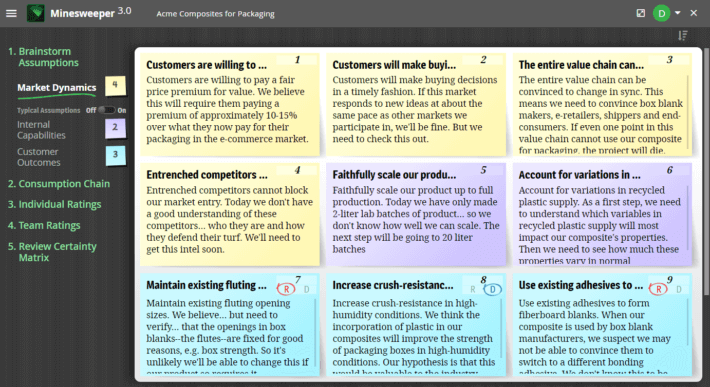
- Rate assumptions: Next the team rates each assumption for its likely impact on project success and its current level of certainty. The illustration from Minesweeper software below illustrates these steps:
-
- Each team member uses an online survey to rate likely impact and certainty on a 1-to-5 anchored scale. Why do this as individuals before the team decides? This avoids “group-think” and ensures rich, divergent thinking.
- The entire team reviews histograms of individual responses and settles on its ratings. What if they can’t agree? Thoughtful project de-risking says the most cautious voice wins… the highest impact rating and lowest certainty rating.
- The team records its Source of Truth. As they learn more in the investigation phase, they’ll continue to add new Sources of Truth.
- Minesweeper software generates a Certainty Matrix. High-impact, low certainty assumptions are in the red “Danger” zone; Low-impact, high-certainty in the green “Safe” zone, and the rest in the yellow “Caution” zone.
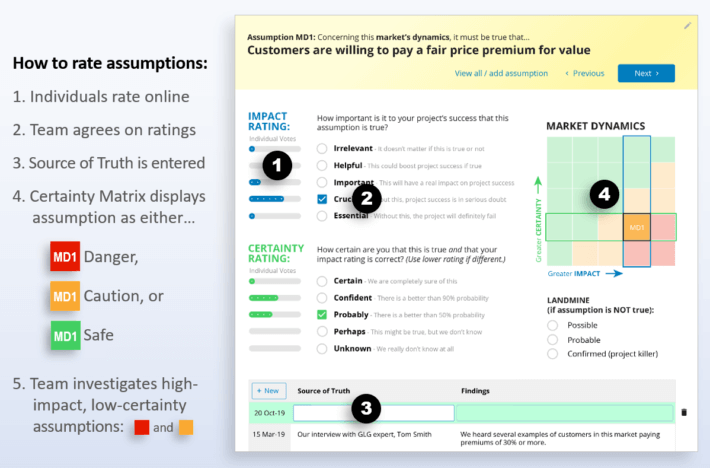
- Investigate assumptions: Next the team prepares a CheckPoint plan… a series of tasks to better understand each assumption. Team members are assigned tasks, e.g. meeting with industry experts, running lab experiments, or interviewing customers. Assumptions move from uncertainty to certainty in the investigation phase of project de-risking. In the screenshot below, an assumption might “move up” from the red Danger zone to the yellow Caution zone, and eventually into the green Safe zone.
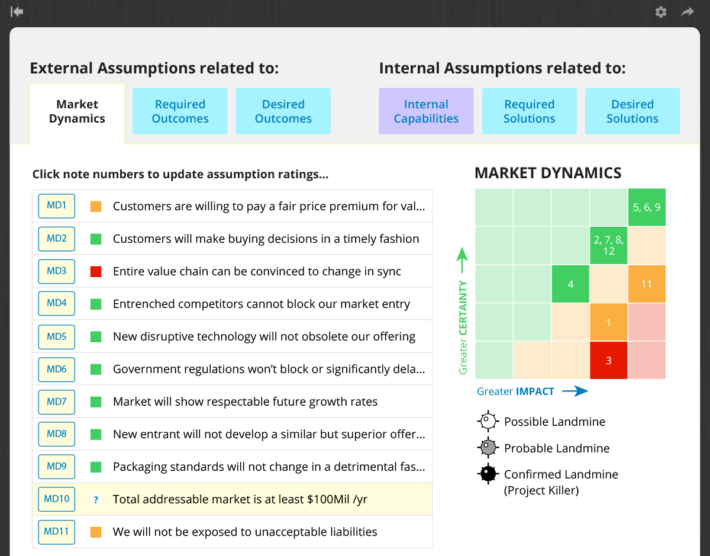
Or an assumption might never become “Safe.” The team may become certain that an assumption they need to be true will in fact not be true. This is called a landmine… something that “blows up” the project. The team carefully monitors assumptions that could become landmines, labeling them…
- Possible landmines,
- Probable landmines, or
- Confirmed landmines.
The team diligently informs management of these landmines as part of its project de-risking. An important project de-risking goal is, “Don’t surprise management.”
Role of the Management Team
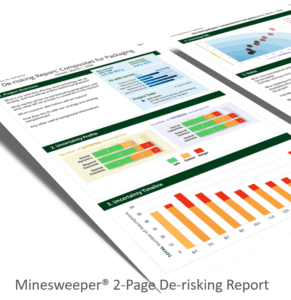
As important as the above steps are, it’s just as important for your team to communicate well with management, and to signal when you do—and do not—need their help. Here are three tips.
First, instead of confusing management with unique, “home-grown” presentations, use a familiar format to provide ongoing updates. If all teams use the same format, your leaders will be able to absorb the content better, and make wiser investment decisions between competing projects. You can download a free sample of the project De-risking Report generated by Minesweeper software.
Second, help your leadership team understand the difference between risk and uncertainty. You can only assign a level of risk if you know the probability of an unfavorable event, e.g., 40% chance of a thunderstorm. It’s pointless to assign probabilities of success, net present values, and so forth in a project’s early phase. That comes later, after your team drives dozens of assumptions from uncertainty to certainty.
Third, let your leaders know there will come a time—after you’ve eliminated most uncertainty—when they’ll be asked to make investment decisions. The chart below illustrates this. When you began project de-risking, your team had many high-impact, low-certainty assumptions (red and yellow)… so the project bubble started in the upper-right.
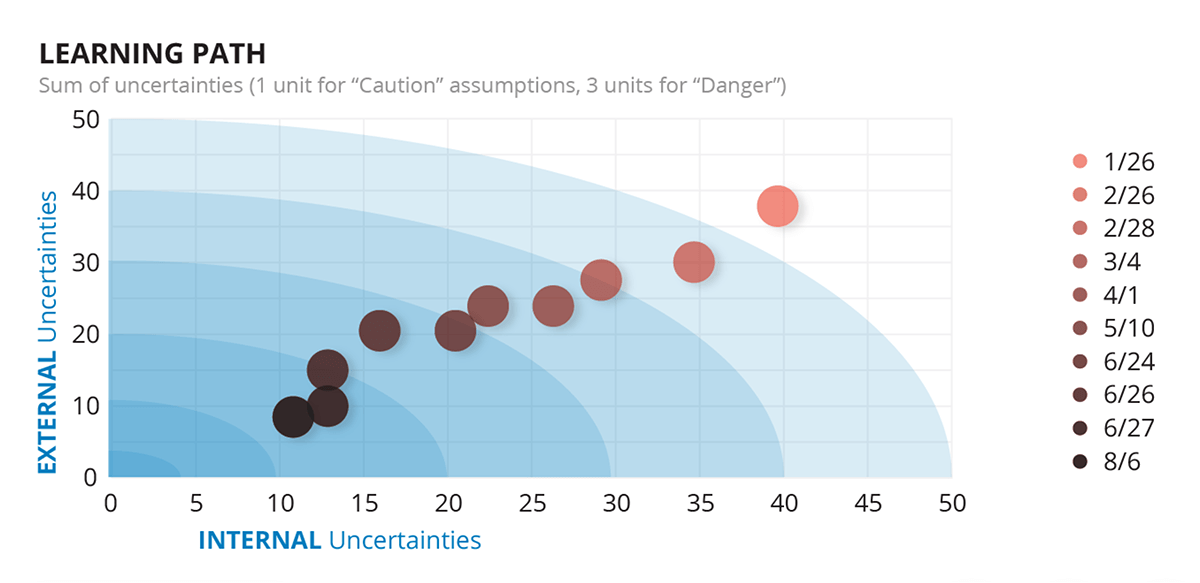
But over time, your team eliminated much of this uncertainty, until now the project bubble is in the lower-left. We call this Minesweeper chart a “learning path,” because this isn’t about risk assessment—something companies try to do far too early. Rather it’s about learning which assumptions—if any—could block your success.
So when do you stop simply updating management, and start asking for decisions? This happens when you’ve driven the bubble as far to the lower-left as you can without an investment decision from them. It could be production scale-up, purchase of capital equipment, funding an alliance, etc. To de-risk projects well is to know when to ask management for their help… and when to move assumptions from uncertainty to certainty quickly and cheaply.
This changes everything
With this approach, management sponsors bolder projects. Sure, many get killed early as landmines are uncovered, but the ones that persist are worthy of major investment. And employees are more willing to be part of these bolder projects, knowing there’s no shame—or negative career implications—when a landmine kills their project.
Want to try project de-risking at your company? Just pick a project for our 2-day in-house workshop to see how powerful it is. Contact us for details. Or send someone to our next open workshop to experience a 1-day simulation of Minesweeper project de-risking.
Comments